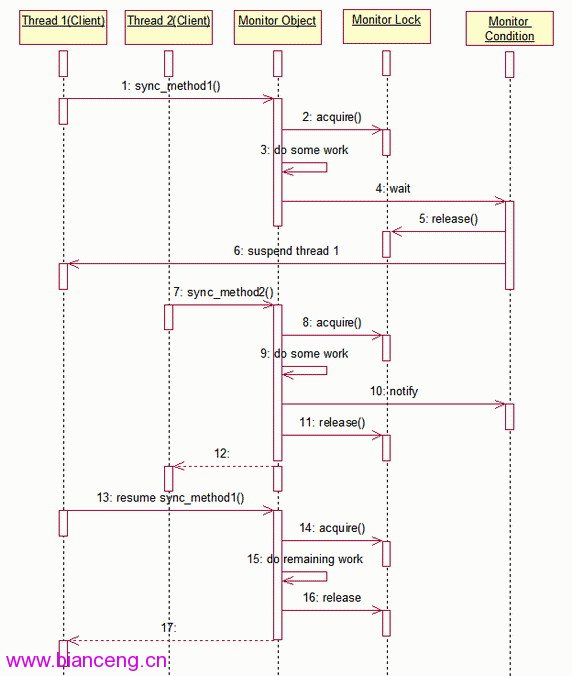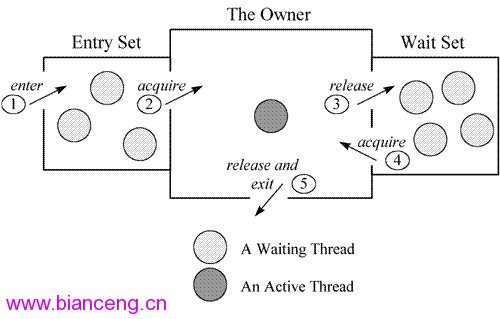本文將從兩個方面進行闡述:
使用 C++ 語言來描述 Monitor Object 設計模式。Java 對於這樣一個典型的 模式做了很好的語言層面的封裝,因此對於 Java 的開發者來說,很多關於該模 式本身的東西被屏蔽掉了。本文試圖使用 Native C++ 語言,幫助讀者從本質上 對 Monitor object 設計模式有一個更全面的認識。
結合 C++ 版本的 Monitor Object 設計模式,引領讀者對於 Java 同步機制 有一個更深刻的認識,幫助讀者正確有效地使用 Java 同步機制。
預備知識
在開始正式討論之前,需要了解一些預備知識。
什麼是 RAII
資源獲取即初始化(RAII, Resource Acquisition Is Initialization)是指 ,在一個對象的構造函數中獲得資源 , 並且在該對象的析構函數中釋放它。這個 資源可以是對象、內存、文件句柄或者其它類型。實現這種功能的類,我們就說 它采用了資源獲取即初始化(RAII)的方式。 RAII 是一種很典型的語言慣用法 ,被很多的 OO 語言所使用,下面是 C++ 的例子。
清單 1. RAII Using C++
class Raii {
public:
// Store a pointer to the resource and initialize the resource.
Raii(Resource &resource)
:m_pRes (&resource){
m_pRes->initialize ();
}
// Close the resource when the execution goes out of scope.
virtual ~Raii() {
m_pRes->close ();
}
private:
// Pointer to the resource we're managing.
Resource *m_pRes;
// ... maybe need disallow copying and assignment ...
};
使用 RAII 的好處是:由於析構函數由系統自動調用,這樣可以幫助我們自動 地隱式釋放我們所獲取的資源。事情上,我們熟知的很多 c++ 技術都用到了這一 設計模式,比如:智能指針 (Smart Pointer),以及我們接下來要討論的范圍鎖 (Scoped Lock) 。
不同於 C++,Java 對象沒有析構函數,Java System 提供了 GC 來管理內存 資源。而對於像數據庫連接,Sockets 這樣類型的資源, Java 提供了 finalize() 來處理。但是,請注意,Java 的 finalizer 與 C++ 的析構函數是 不同的,finalize() 函數由 GC 異步地在某個恰當的時候調用,我們不能等同地 使用 finalize() 來實現 C++ 裡的 RAII 。通常的做法是使用 Java 提供的 finally 語句塊。
清單 2. RAII Using Java
MyResource res = null;
try {
res = new MyResource();
// Use the resource
} finally {
//At exit point, close the resource.
if (res != null) { res.close(); }
}
什麼是區域鎖 (Scoped Lock)
區域鎖是指線程執行進入一個區域時,一個鎖將自動被獲取,當該線程執行離 開這個區域時,這個鎖將被自動釋放。 C++ 區域鎖的實現使用了 RAII 技術 , 實現如下。
清單 3. Scoped Lock Using C++
template <class LOCK>
class Guard {
public:
// Store a pointer to the lock and acquire the lock.
Guard (LOCK &lock)
:m_pLlock (&lock), m_bOwner (false) {
m_pLlock->acquire ();
m_bOwner = true;
}
// Release the lock when the guard goes out of scope,
// but only if <acquire> succeeded.
virtual ~Guard () {
if (m_bOwner) m_pLlock->release ();
}
private:
// Pointer to the lock we're managing.
LOCK *m_pLlock;
// Records if the lock is held by this object.
bool m_bOwner;
// ... maybe need disallow copying and assignment ...
};
Guard 是一個模板類,LOCK 類型指的是對操作系統提供的線程鎖的抽象,比 如,在 Windows 平台上,LOCK 可以是對 CRITICAL_SECTION 的封裝。
那麼對於 Java,怎麼實現區域鎖呢?不必擔心,Java 對於區域鎖模式在語言 層面上已經做了封裝,所以對於 Java 開發者來說,不必像 C++ 這樣來開發自己 的區域鎖類,這就是我們所熟知的 synchronized 關鍵字。
清單 4. Scoped Lock Using Java
public int scopedLockSample() {
synchronized(this) {
try {
//do some work…
} catch( MyException1 e) {
//no need release lock explicitly
return -1;
} catch( MyException2 e) {
//no need release lock explicitly
return -2;
}
//other exceptions handling...
}
return 0;
}
synchronized 保證在進入該區域後,獲得對象鎖,不管最終該函數從哪裡退 出,該對象鎖都會被正確釋放。
什麼是條件變量 (Condition Variables)
條件變量通常被一個線程用於使自己等待,直到一個涉及共享數據的條件表達 式到達特定的狀態。當另外的協作線程指示共享數據的狀態已發生變化,調度器 就喚醒在該條件變量上掛起的線程。於是新喚醒的線程重新對它的條件表達式進 行求值,如果共享數據已到達合適狀態,就恢復處理。以下是條件變量的 C++ 實 現。
清單 5. Thread Condition Using C++
class Thread_Condition {
public:
// Initialize the condition variable and associate it with the specified lock.
Thread_Condition (const Thread_Mutex &m)
:m_obMutex(m) {
cond_init (&cond_, USYNC_THREAD, 0);
}
// Destroy the condition variable.
virtual ~Thread_Condition () {
cond_destroy (&cond_);
}
// Wait for the <Thread_Condition> to be notified
// or until <timeout> has elapsed. If <timeout> == 0 then wait indefinitely.
void wait (Time_Value *timeout = 0) {
cond_timedwait(&cond_, &m_obMutex.m_lock,timeout == 0?0:timeout->msec ());
}
// Notify one thread waiting on <Thread_Condition>.
void notify () { cond_signal (&cond_); }
// Notify all threads waiting on <Thread_Condition>.
void notify_all () { cond_broadcast (&cond_);
}
private:
// Solaris condition variable.
cond_t cond_;
// Reference to mutex lock.
const Thread_Mutex &m_obMutex;
};
Thread_Condition 的實現與操作系統提供的 API 密切相關,以上的例子是基 於 Solaris condition variable API 的面向對象的封裝。另外,這裡的 Thread_Mutex 類型是對操作系統提供的線程鎖的面向對象的封裝 (Thread_Mutex 類型就是 Guard 模板參數 LOCK 所指向的類型 ) 。
而對於 Java,問題就變得簡單很多,你不需要去封裝自己的條件變量類, Java 的根類 Object 提供了 wait/notify/notifyAll 方法給開發者,很容易使 用,這個我們在後面的討論中會看到。
Monitor Object 設計模式 C++ 描述
我們將從以下幾個方面來討論 Monitor Object 模式。
問題描述
我們在開發並發的應用時,經常需要設計這樣的對象,該對象的方法會在多線 程的環境下被調用,而這些方法的執行都會改變該對象本身的狀態。為了防止競 爭條件 (race condition) 的出現,對於這類對象的設計,需要考慮解決以下問 題:
在任一時間內,只有唯一的公共的成員方法,被唯一的線程所執行。
對於對象的調用者來說,如果總是需要在調用方法之前進行拿鎖,而在調用方 法之後進行放鎖,這將會使並發應用編程變得更加困難。合理的設計是,該對象 本身確保任何針對它的方法請求的同步被透明的進行,而不需要調用者的介入。
如果一個對象的方法執行過程中,由於某些條件不能滿足而阻塞,應該允許其 它的客戶端線程的方法調用可以訪問該對象。
我們使用 Monitor Object 設計模式來解決這類問題:將被客戶線程並發訪問 的對象定義為一個 monitor 對象。客戶線程僅僅通過 monitor 對象的同步方法 才能使用 monitor 對象定義的服務。為了防止陷入競爭條件,在任一時刻只能有 一個同步方法被執行。每一個 monitor 對象包含一個 monitor 鎖,被同步方法 用於串行訪問對象的行為和狀態。此外,同步方法可以根據一個或多個與 monitor 對象相關的 monitor conditions 來決定在何種情況下掛起或恢復他們 的執行。
結構
在 Monitor Object 模式中,主要有四種類型的參與者:
監視者對象 (Monitor Object): 負責定義公共的接口方法,這些公共的接口 方法會在多線程的環境下被調用執行。
同步方法:這些方法是監視者對象所定義。為了防止競爭條件,無論是否同時 有多個線程並發調用同步方法,還是監視者對象含有多個同步方法,在任一時間 內只有監視者對象的一個同步方法能夠被執行。
監視鎖 (Monitor Lock): 每一個監視者對象都會擁有一把監視鎖。
監視條件 (Monitor Condition): 同步方法使用監視鎖和監視條件來決定方法 是否需要阻塞或重新執行。
執行序列圖
在監視者對象模式中,在參與者之間將發生如下的協作過程:
1、同步方法的調用和串行化。當客戶線程調用監視者對象的同步方法時,必 須首先獲取它的監視鎖。只要該監視者對象有其他同步方法正在被執行,獲取操 作便不會成功。在這種情況下,客戶線程將被阻塞直到它獲取監視鎖。當客戶線 程成功獲取監視鎖後,進入臨界區,執行方法實現的服務。一旦同步方法完成執 行,監視鎖會被自動釋放,目的是使其他客戶線程有機會調用執行該監視者對象 的同步方法。
2、同步方法線程掛起。如果調用同步方法的客戶線程必須被阻塞或是有其他 原因不能立刻進行,它能夠在一個監視條件上等待,這將導致該客戶線程暫時釋 放監視鎖,並被掛起在監視條件上。
3、監視條件通知。一個客戶線程能夠通知一個監視條件,目的是為了讓一個 前期使自己掛起在一個監視條件上的同步方法線程恢復運行。
4、同步方法線程恢復。一旦一個早先被掛起在監視條件上的同步方法線程獲 取通知,它將繼續在最初的等待監視條件的點上執行。在被通知線程被允許恢復 執行同步方法之前,監視鎖將自動被獲取。圖 1 描述了監視者對象的動態特性。
圖 1. Monitor Object Sequence Diagram.

示例
在本節中,我們將使用監視者對象設計模式來解決一個實際的問題。
這是一個典型的生產者 / 消費者模式問題。假定我們有一個固定長度的消息 隊列,該隊列會被多個生產者 / 消費者線程所操作,生產者線程負責將消息放入 該隊列,而消費者線程負責從該對列中取出消息。
清單 6. Message_Queue.h
class Message_Queue {
public:
enum { MAX_MESSAGES = 100/* ... */ };
// The constructor defines the maximum number
// of messages in the queue. This determines when the queue is 'full.'
Message_Queue(size_t max_messages = MAX_MESSAGES);
virtual ~Message_Queue();
// Put the <Message> at the tail of the queue.
// If the queue is full, block until the queue is not full.
/* synchronized */
void put (const Message &msg);
// Get the <Message> from the head of the queue
// and remove it. If the queue is empty, block until the queue is not empty.
/* synchronized */
Message get();
// True if the queue is empty, else false.
/* synchronized */
bool empty () const;
// True if the queue is full, else false.
/* synchronized */
bool full () const;
private:
// Put the <Message> at the tail of the queue, and
// get the <Message> at its head, respectively.
// Note that, the internal methods are not synchronized.
void put_i (const Message &msg);
Message get_i ();
// True if the queue is empty, else false.
bool empty_i () const;
// True if the queue is full, else false.
bool full_i () const;
private:
// Internal Queue representation omitted, could be a
// circular array or a linked list, etc.. ...
// Current number of <Message>s in the queue.
size_t message_count_;
// The maximum number <Message>s that can be
// in a queue before it's considered 'full.'
size_t max_messages_;
// Monitor lock that protects the queue's
// internal state from race conditions during concurrent access.
mutable Thread_Mutex monitor_lock_;
// Condition variable used in conjunction with <monitor_lock_> to make
// synchronized method threads wait until the queue is no longer empty.
Thread_Condition not_empty_;
// Condition variable used in conjunction with <monitor_lock_> to make
// synchronized method threads wait until the queue is no longer full.
Thread_Condition not_full_;
};
清單 7. Message_Queue.cpp
#include "Message_Queue.h"
Message_Queue::Message_Queue (size_t max_messages)
:not_full_(monitor_lock_),
not_empty_(monitor_lock_),
max_messages_(max_messages),
message_count_(0) {
}
bool Message_Queue::empty () const {
Guard<Thread_Mutex> guard (monitor_lock_);
return empty_i ();
}
bool Message_Queue::full () const {
Guard<Thread_Mutex> guard (monitor_lock_);
return full_i ();
}
void Message_Queue::put (const Message &msg) {
// Use the Scoped Locking idiom to acquire/release the < monitor_lock_> upon
// entry/exit to the synchronized method.
Guard<Thread_Mutex> guard (monitor_lock_);
// Wait while the queue is full.
while (full_i ()) {
// Release < monitor_lock_> and suspend the
// calling thread waiting for space in the queue.
// The <monitor_lock_> is reacquired automatically when <wait> returns.
not_full_.wait ();
}
// Enqueue the <Message> at the tail.
put_i (msg);
// Notify any thread waiting in <get> that the queue has at least one <Message>.
not_empty_.notify ();
} // Destructor of <guard> releases <monitor_lock_>.
Message Message_Queue::get () {
// Use the Scoped Locking idiom to acquire/release the <monitor_lock_> upon
// entry/exit to the synchronized method.
Guard<Thread_Mutex> guard (monitor_lock_);
// Wait while the queue is empty.
while (empty_i ()) {
// Release <monitor_lock_> and suspend the
// calling thread waiting for a new <Message> to
// be put into the queue. The <monitor_lock_> is
// reacquired automatically when <wait> returns.
not_empty_.wait ();
}
// Dequeue the first <Message> in the queue and update the <message_count_>.
Message m = get_i ();
// Notify any thread waiting in <put> that the
// queue has room for at least one <Message>.
not_full_.notify ();
return m;
} // Destructor of <guard> releases <monitor_lock_>.
bool Message_Queue::empty_i () const {
return message_count_ == 0;
}
bool Message_Queue::full_i () const {
return message_count_ == max_messages_;
}
Message_Queue::~Message_Queue() {
}
Monitor Object Java 實踐
認識 Java Monitor Object
Java Monitor 從兩個方面來支持線程之間的同步,即:互斥執行與協作。 Java 使用對象鎖 ( 使用 synchronized 獲得對象鎖 ) 保證工作在共享的數據集 上的線程互斥執行 , 使用 notify/notifyAll/wait 方法來協同不同線程之間的 工作。這些方法在 Object 類上被定義,會被所有的 Java 對象自動繼承。
實質上,Java 的 Object 類本身就是監視者對象,Java 語言對於這樣一個典 型並發設計模式做了內建的支持。不過,在 Java 裡,我們已經看不到了我們在 C++ 一節所討論的區域鎖與條件變量的概念。下圖很好地描述了 Java Monitor 的工作機理。
圖 2. Java Monitor

線程如果獲得監視鎖成功,將成為該監視者對象的擁有者。在任一時刻內,監 視者對象只屬於一個活動線程 (Owner) 。擁有者線程可以調用 wait 方法自動釋 放監視鎖,進入等待狀態。
示例
在本節,我們將用 Java Monitor 來重新解決用 C++ 實現的生產者 / 消費者 模式問題。
清單 8. Message Class
public class Message {
private static int OBJ_COUNT = 0;
public int obj_index_;
Message(){
synchronized(Message.class) {
OBJ_COUNT++;
obj_index_ = OBJ_COUNT;
}
}
@Override
public String toString() {
return "message["+obj_index_+"]";
}
}
清單 9. MessageQueue Class
public class MessageQueue {
private int message_count_;
private int max_messages_;
private Message[] buffer_;
private int in_ = 0, out_ = 0;
public MessageQueue(int max_messages) {
max_messages_ = max_messages;
message_count_ = 0;
buffer_ = new Message[max_messages_];
}
synchronized boolean full () {
return full_i ();
}
synchronized void put (Message msg) {
while (full_i ()) {
try {
System.out.println("thread["+
Thread.currentThread().getId()+
"]"+
"release monitor lock, wait for space in the queue");
wait();
} catch (InterruptedException e) {
//do something.
} finally {
//do something.
}
}//end while.
put_i(msg);
notifyAll();
}
synchronized Message get() {
while (empty_i ()) {
try {
System.out.println("thread["+
Thread.currentThread().getId()+
"]"+
"release monitor lock, wait for message in the queue");
wait();
} catch (InterruptedException e) {
//do something.
} finally {
//do something.
}
}//end while.
Message m = get_i ();
notifyAll();
return m;
}
private boolean empty_i () {
return message_count_ == 0;
}
private boolean full_i () {
return message_count_ == max_messages_;
}
private void put_i (Message msg) {
System.out.println("thread ["+
Thread.currentThread().getId()+
"] put message <"+
msg+
">" +
"to the queue");
buffer_[in_] = msg;
in_ = (in_ + 1) % max_messages_;
message_count_++;
}
private Message get_i() {
Message msg = buffer_[out_];
out_= (out_ + 1) % max_messages_;
message_count_--;
System.out.println("thread ["+
Thread.currentThread().getId()+
"] get message <"+
msg+
">" +
"from the queue");
return msg;
}
}
在 Java 的示例中,沒有放更多的注釋,希望讀者通過對照 C++ 的示例,來 閱讀理解這裡的 Java 代碼。可以看到,使用 Java 的版本代碼簡潔了很多。另 外,這裡提供的 Java 代碼,稍作修改,是直接可以作為獨立的 Java 程序運行 的。
總結
我們對比一下 Monitor Object 設計模式的 C++ 版本與 Java 版本,做出如 下的總結。
在 Java 的版本中,我們不需要親自開發 Scoped Lock,Thread Condition 類,Java 語言給我們提供了內建的支持,我們很容易使用 synchronized, wait/notify 這些 Java 特性來構建基於 Monitor Object 模式的應用。而缺點 是:缺乏一些必要的靈活性。比如 : 在 Java 的版本中,我們並不能區分出 not empty 與 not full 這兩個條件變量,所以我們只能使用 notifyAll 來通知所有 等待者線程,而 C++ 版本使用了不同的通知喚醒:not_full_.notify 與 not_empty_.notify 。同樣,在 Java 中對於 synchrnonized 的使用,後面一定 要跟 {} 語句塊,這在代碼的書寫上有些不靈活,而在 C++ 中的,Scoped Lock 默認就是保護當前的語句塊,當然你也可以選擇使用 {} 來顯式聲明。而且,使 用 synchroninzed 所獲得的對象鎖,無法細粒度地區分是獲得讀鎖還是寫鎖。
不過總的來說,Java 的確簡化了基於 Monitor Object 並發模式的開發。不 過,我們應該意識到,並發的實際應用開發決不會像 Java 語法這麼體現出來的 簡單,簡潔。我們更應該看到並發應用程序本質的一些東西,這有利於幫助我們 構建更加健壯的並發應用。